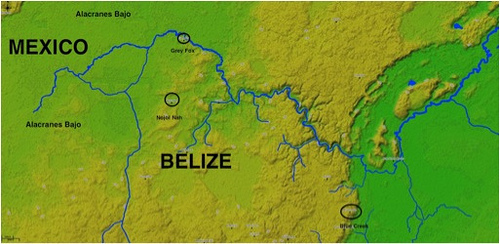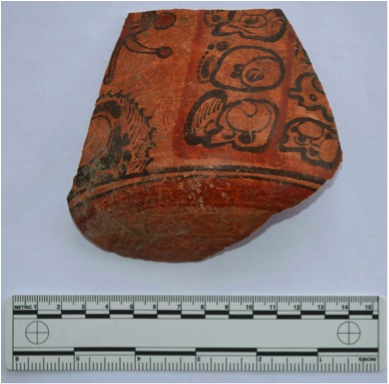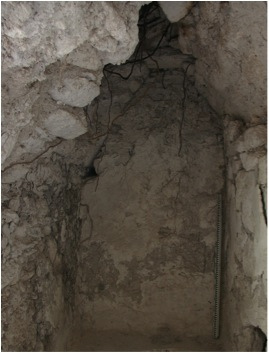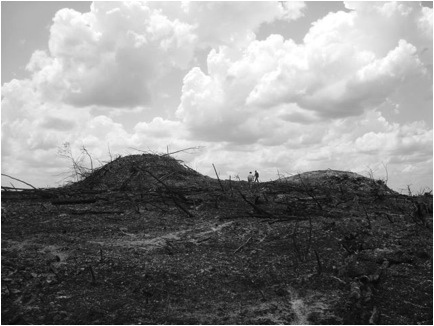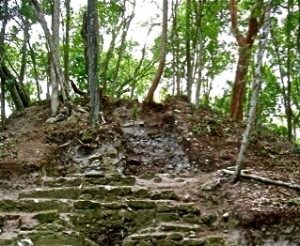
The Alacranes Bajo, a low-lying, highly fertile and productive stretch of land which extends across Belize’s northwest corner and parts of Mexico and Guatemala, has been farmed intensively for centuries by the ancient Maya. Today is no different, with its modern inhabitants continuing to clear the land.
One would think that this is a good thing. After all, agricultural development feeds people and can raise many a family out of the misery of poverty. But progress, particularly in Belize and its Central American neighboring countries, often comes at a steep price, as locations and resources that represent critical cultural heritage and undiscovered history are lost to the bulldozer and other human tools for development, not to mention looting and inadvertent destruction caused by casual visitors. This is the looming fate for many of the ancient settlements, known and unknown, that dot the Belizean landscape on the east side of the Alacranes Bajo.
Nojol Nah is one such site. Archaeologists have been working at this site under the auspices of the Maya Research Program (MRP), a non-provit organization that has done extensive excavation and research at the larger Maya center of Blue Creek, also in Belize. Only a portion of the Nojol Nah site has been unearthed thus far, but they have already uncovered a wealth of new artifacts and features.
“The most significant finds from Nojol Nah from the past 5 seasons of excavations has been the incredible number of burials that have been recovered,” says Colleen Hanratty, a member of the Board of Directors of MRP and a leading, long-time researcher and field archaeologist with the organization. “To date, we have recovered 67 burials from the excavation of 16 residential structures. For scale – we have recovered 57 burials from the site of Blue Creek and it’s residential components in 20 seasons of excavations. We have also recovered numerous caches, termination deposits, elite household middens* that produced sherds with glyphs, and chultuns**, as well as elite and public architecture.” Anciently, construction began at the site during the Late Preclassic period (400 BCE – 200 CE).
__________________________________________________________________________________________
Overview of NW Belize, with Nojol Nah site circled near the center of the image and showing its geographic positioning near the Alacranes Bajo. Courtesy Maya Research Program
_________________________________________________________________________________________
Overview of an elite residence at Nojol Nah. Courtesy Maya Research Program
__________________________________________________________________________________________
Polychrome sherd with glyphs, found at Nojol Nah. Courtesy Maya Research Program
_________________________________________________________________________________________
Intact vaulted room at Tulix Mul, a component of Nojol Nah. Courtesy Maya Research Program
_________________________________________________________________________________________
Perhaps the most sensational finds emerged at Tulix Mul, an outlier component of Nojol Nah, where archaeologists have recently uncovered a mural. Considered relatively rare, only a few other Maya sites in Mesoamerica have featured such art, arguably the best known being Bonampak in Mexico and San Bartolo in Guatemala.
Although the finds at Nojol Nah and Tulix Mul are significant in themselves, archaeologists emphasize that the most important takeaway is the invaluable information they afford, in conjunction with that of other excavations they are conducting in the area, for significantly expanding both scholarly and public understanding about the structure and dynamics of ancient Maya society and land use.
“We continue to strive to understand the nature of a Maya city,” says Hanratty. “By comparing numerous sites in the area, we are working toward a better picture of the ancient Maya landscape. In addition, our work is also shedding new light on the nature of the so-called Terminal Classic “collapse” and subsequent abandonment of the area, including Post- classic reoccupation.”
But Hanratty makes clear that there is a serious threat to the preservation of the site and the important research being conducted there. “The Alacranes Bajo is a low lying area that is very fertile and continues to be today. Unfortunately, just as the Maya farmed this area extensively in the past, the modern inhabitants of the area are also intensively farming the area and converting this land to cattle pasture. Due to modern technologies the negative impact on the natural and cultural resources is severe. This is why MRP is interested in conserving sites in the area, including those we haven’t identified.”
To underscore the seriousness of the situation, the MRP reports that by 2010, thousands of acres surrounding Nojol Nah had already been cleared, leaving the site as an island of forest and biological refugium. Scientists and preservationists are almost certain that, unless action is taken, the site and the valuable archaeology and cultural information it holds will be destroyed.
__________________________________________________________________________________________
Recently cleared land in NW Belize. Courtesy Maya Research Program
_______________________________________________________________________________
Saving Nojol Nah
The MRP and others are not waiting on the outside world to take action. Instead, they are taking the initiative to build on a concept that has worked for them in the recent past: If you want to protect a site, buy it.
It is a strategy that worked well when they acquired the land on which rested the ancient remains of Grey Fox (named after a type of fox that is indigenous to the area), a nearby site that contains two large public plazas, a large pyramid, large royal elite residences and viewing galleries, and a probable ballcourt. About 90 acres were purchased for $36,000, and Grey Fox immediately fell off the radar for endangered sites. Conservationsts and scientists at the MRP are now hoping that the same can be done for Nojol Nah and its outlying component, Tulix Mul.
Important progress has already been made. The Archaeological Insitute of America (AIA) has awarded MRP with a Site Preservation Grant for Tulix Mul, which will protect the Maya murals and establish a permanent outreach program involving the local community. In addition, MRP, in collaboration with Popular Archaeology Magazine, has launched a fund-raising campaign through the magazine’s Adopt-a-Site program to acquire the necessary funds to purchase up to 100 acres to protect Nojol Nah and other sites in the area.
Says Dan McLerran, Owner and Editor of Popular Archaeology, “We look at it as saving the past for the future. For so many countries, and for the world at large, preserving and researching our cultural heritage is a vital part of global, national and local community identity. And for the people who live in the local communities associated with the sites, it can be a real source of income for their struggling economies and households in terms of tourism, outreach and museums. Nojol Nah is one place where this can be realized.”
See this website for more information about the Maya Research Program, and Adopt-a-Site for more information about Nojol Nah and the donation program.
_____________________
*A midden, in archaeological parlence, is a dump or feature containing discarded waste products relating to day-to-day human life.
** A chultun is an underground storage chamber which usually functions as a cistern for potable water.
Cover Photo, Top Left: Structure 1 at Nojol Nah. Courtesy Maya Research Program
_______________________________________________________________________________________________________________________
Read about the most fascinating discoveries with a premium subscription to Popular Archaeology Magazine. Find out what Popular Archaeology Magazine is all about, including the special Holiday Discount offer. AND MORE:
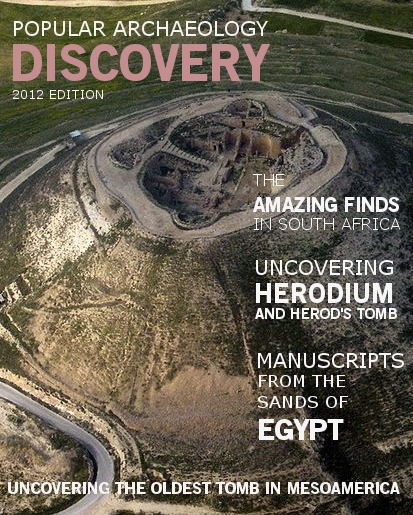 On the go? Purchase the mobile version of the current issue of Popular Archaeology Magazine here for only $2.99.
On the go? Purchase the mobile version of the current issue of Popular Archaeology Magazine here for only $2.99.
And, Popular Archaeology’s annual Discovery edition is a selection of the best stories published in Popular Archaeology Magazine in past issues, with an emphasis on some of the most significant, groundbreaking, or fascinating discoveries in the fields of archaeology and paleoanthropology and related fields. At least some of the articles have been updated or revised specifically for the Discovery edition. We can confidently say that there is no other single issue of an archaeology-related magazine, paper print or online, that contains as much major feature article content as this one. The latest issue, volume 2, has just been released. Go to the Discovery edition page for more information.
Subscription Price: A very affordable $5.75 for those who are not already premium subscribers of Popular Archaeology Magazine (It is FREE for premium subscribers to Popular Archaeology). Premium subscribers should email [email protected] and request the special coupon code. Or, for the e-Book version, it can be purchased for only $3.99 at Amazon.com.

